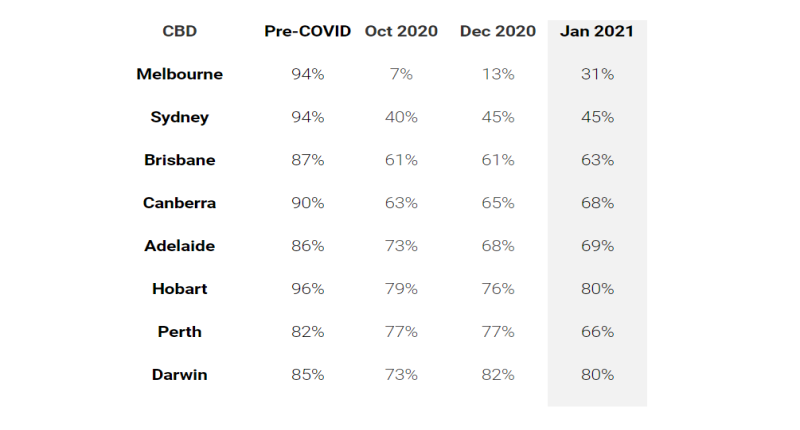- Survey data shows CBD workers coming back to the office in January
- PCA Chief Executive says results are a good sign, but more progress is still needed
- Office managers are optimistic that the increase in occupancy levels will continue
New survey data released by the Property Council of Australia (PCA) shows CBD workers returned to the office in strong numbers in January.
The survey figures are based on responses from Property Council members who own or manage CBD buildings and cover occupancy for the period from 27 January to 4 February 2021. It revealed that nearly all capital city CBDs were busier at the end of January than they had been before Christmas.
Office occupancies from December 2020 to January 2021 increased for Brisbane, Canberra, Adelaide, and Hobart.
In particular, Melbourne’s CBD saw the strongest rebound, more than doubling occupancy over the summer from 13% before Christmas to 31% in the week after Australia Day.
However, occupancies decreased in Perth and Darwin (Perth suffering a sharp decline from 77% to 66% due to the snap 5-day lockdown), while Sydney remained at 45%.
Property Council Chief Executive Ken Morrison said the survey results are a positive sign for Australia’s economic recovery, but there was still more progress needed.
“As we start the new year it is encouraging to see so many CBD workers coming back to their offices to enjoy the benefits of face-to-face connections and collaboration.
“While we have a long way to go to get back to pre-COVID levels, increased CBD occupancy is a godsend for the thousands of businesses that rely on bustling city centres to survive.”
Respondents of the survey pointed to a drop in government public health restrictions and reduced safety concerns as factors contributing towards increased occupancy. Worker preferences for greater flexibility were recorded as the predominant reason preventing a return to pre-COVID levels of occupancy.
Office building managers are increasingly expecting a material increase in occupancy levels within the next 1-2 months.
Mr Morrison said that building owners and managers have been working tirelessly to ensure workplaces are COVID-safe to support tenant businesses and their employees in returning to full productivity.
“There’s now a growing impetus for people to come back to their workplaces as public health restrictions are scaled down.
“The mission for policymakers, employers, and the property industry over the coming months will be to maintain momentum and ensure our CBDs return to full activity as quickly as possible.”





